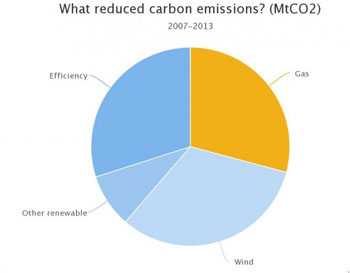Have you noticed that natural gas gets all the credit for bringing US emissions down and for the closure of coal plants?
The credit should actually go to wind energy, according to Greenpeace EnergyDesk, which analyzed the data the US Energy Information Agency used to come to those conclusions – which have since been spread widely by the press.
US emissions declined 16% from 2007-2012 mostly because of renewable energy (40%), followed by energy efficiency (30%) and greater use of natural gas (30%), according to the data.
Even more striking is that wind power alone accounts for 32% of the drop – a slightly larger contribution than natural gas.
And that’s without counting methane leaks from fracking.
"The supposed
climate benefits of fracking have been a big selling point for the shale lobby,
but this myth has now been cut down to size by compelling new evidence," says Lauri Myllyvirta, an energy analyst for Greenpeace. "Our analysis shows that
it was the clean tech boom, not the fracking rush, that slashed the bulk of
carbon emissions from the US power sector."

Coal Dropped, What Filled in the Gap?
Here’s a more factual way of saying it: between 2007-13 the US experienced the largest fall in coal use ever experienced by any country (a drop of 21%), and renewables, energy efficiency and shale gas together picked up the slack.
Renewable energy plays the biggest role because it produces zero emissions in contrast to natural gas. During that time, renewable energy in the US grew by 48.1%, with wind generation nearly quadrupling, spurred by tax credits.
Energy efficiency replaced 21% of the coal no longer used and gas replaced 44%.

In 2013, US emissions started rising again because of the surge in crude oil production (up 31%) and because utilities have been able to buy coal at prices cheaper than gas.
Coal use is expected to fall by another 25% by 2020 as many plants close, leading Greenpeace to project that rising emissions will be short-lived.
Meanwhile, in Scandinavia, wind power is blowing gas and coal-fired turbines out of business, reports Scientific American.
Fossil fuel plants are used to fill in when hydropower falls in dry weather, but wind energy has reached a scale where this isn’t even needed. And wind has also pushed prices down, eroding profitability of fossil power stations.
Read our article, Renewable Energy Surpasses Gas in 2015.
Read the full Scientific American article:
